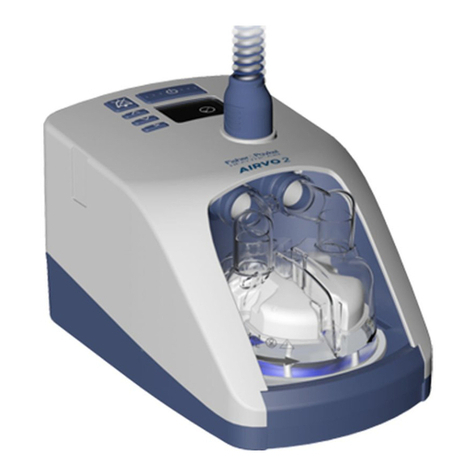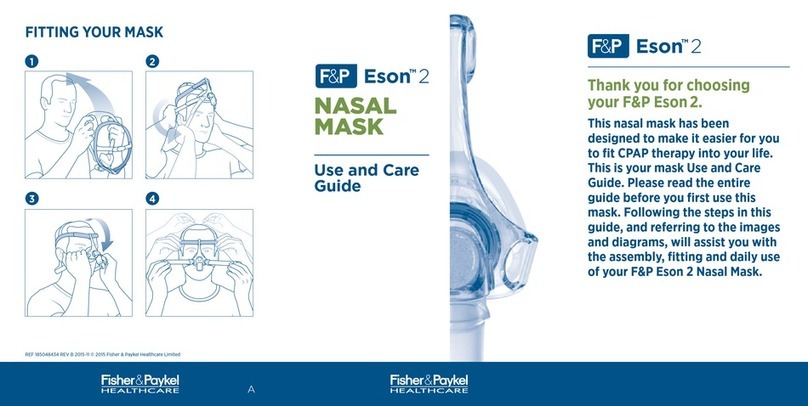
Airvo 3 - USER MANUAL | A - 5
English
• Do not expose the Airvo 3 battery to water, fire or excessive heat. Do not crush, disassemble orpuncture the battery, or short-circuit the
connector terminals.
• In the event of a battery leaking, do not allow the liquid to come in contact with the skin or eyes. If contact has been made, wash the
aected area with copious amounts of water and seek medical advice.
• Seek medical advice immediately if a cell or a battery has been swallowed.
• Changes or modifications not expressly approved by Fisher & Paykel Healthcare voids the user’s authority to operate the device.
• Do not use any solutions, suspensions, emulsions, anesthetic or respirable gases that are not identified in these user instructions.
Theymay not be compatible with the patient consumables, device or accessories.
• Use only genuine F&P replacement battery modules to prevent damage to the Airvo 3, excessive temperatures, fire or explosion.
Operating environment
• Do not use the Airvo 3 above the altitude range listed in the specifications section of the manual.
• Do not use the Airvo 3 when outside the operating conditions listed in the specifications section. Therapy may be compromised outside
this range.
• Do not use the Airvo 3 in a magnetic resonance imaging (MRI) environment.
• Do not use the Airvo 3 with, or in the presence of, a flammable anesthetic mixture with air or oxygen.
• Do not use the Airvo 3, or accessories, during defibrillation.
• Do not use the Airvo 3, or accessories, near any ignition source, including electrosurgery, electrocautery, or laser surgery instruments.
Exposure to oxygen increases the risk of fire that may result in patient injury.
• Do not use the Airvo 3 in a hyperbaric chamber.
• Avoid using the Airvo 3, or accessories, adjacent to, or stacked with, other equipment, which could result in improper operation. If such
use is necessary, this equipment and the other equipment should be observed to verify that they are operating normally.
• The Airvo 3 is not designed for use in the home.
Caution
• The emissions characteristics of this equipment make it suitable for use in industrial areas and hospitals (CISPR 11 class A). If it is used in
a residential environment (for which CISPR 11 class B is normally required) this equipment might not oer adequate protection to
radio-frequency communication services. The user might need to take mitigation measures, such as relocating or re-orienting the
equipment.
To avoid burns
• Do not touch the hot surface of the heater-plate or chamber base.
• Never operate the Airvo 3 if:
– the heated breathing tube has been damaged in any way including holes, tears or kinks,
– it is not working properly, or
– water has entered the device.
• Do not restrict ventilation around the Airvo 3, which may cause it to overheat.
• Do not block the flow of air through the Airvo 3 or breathing tube.
To avoid electric shock
• Do not store or use the Airvo 3 where it can fall, or be pulled, into water. Disconnect the power cord and stop using the Airvo 3 if water
has entered the case.
• Never operate the Airvo 3 if it has, or is suspected of having:
– been dropped or damaged,
– a damaged power cord or plug, or
– been dropped into water.
• See the Airvo3 Technical Manual for instructions to replace a damaged power cord.
• Do not attempt to adjust, repair, open, disassemble or modify the Airvo 3 except as described in this user manual or the Airvo3
Technical Manual. Return the Airvo 3 to your Fisher & Paykel Healthcare representative for servicing, if necessary.
• Do not touch the patient at the same time as any conductive parts of the device, such as USB ports.
Notes
• If a serious incident has occurred while using this device please inform your local Fisher & Paykel Healthcare representative and
Competent Authority in your country.































